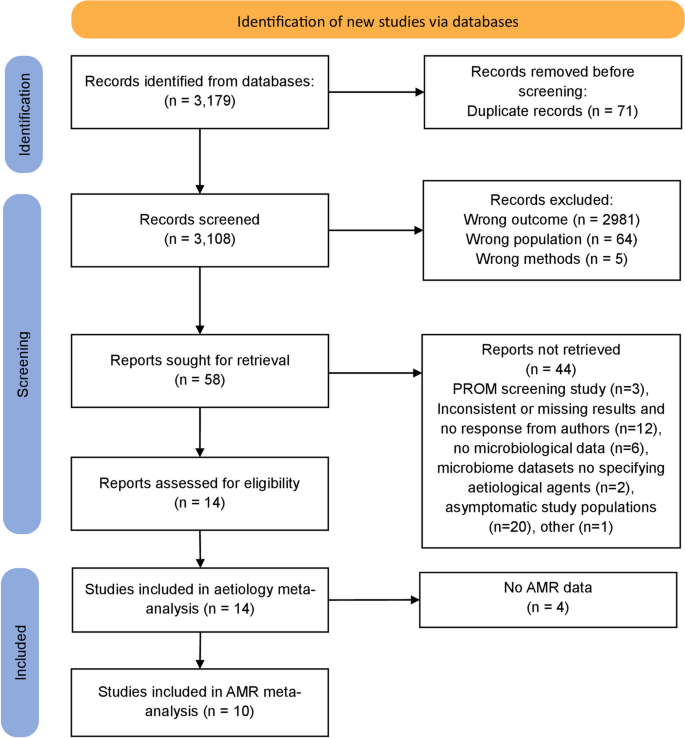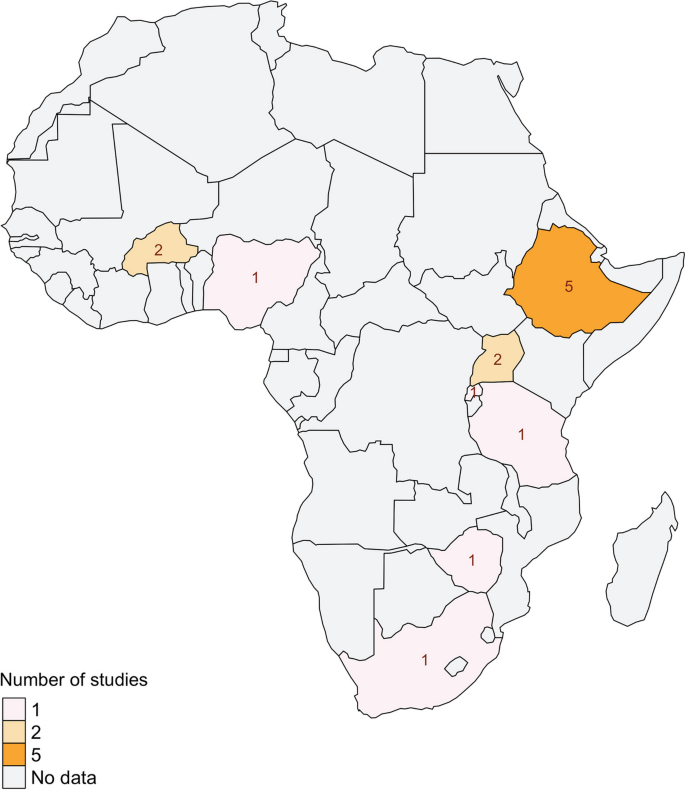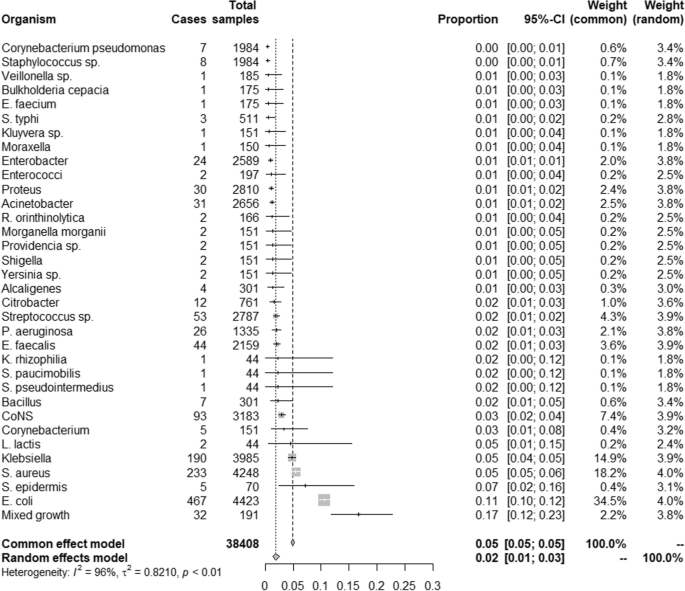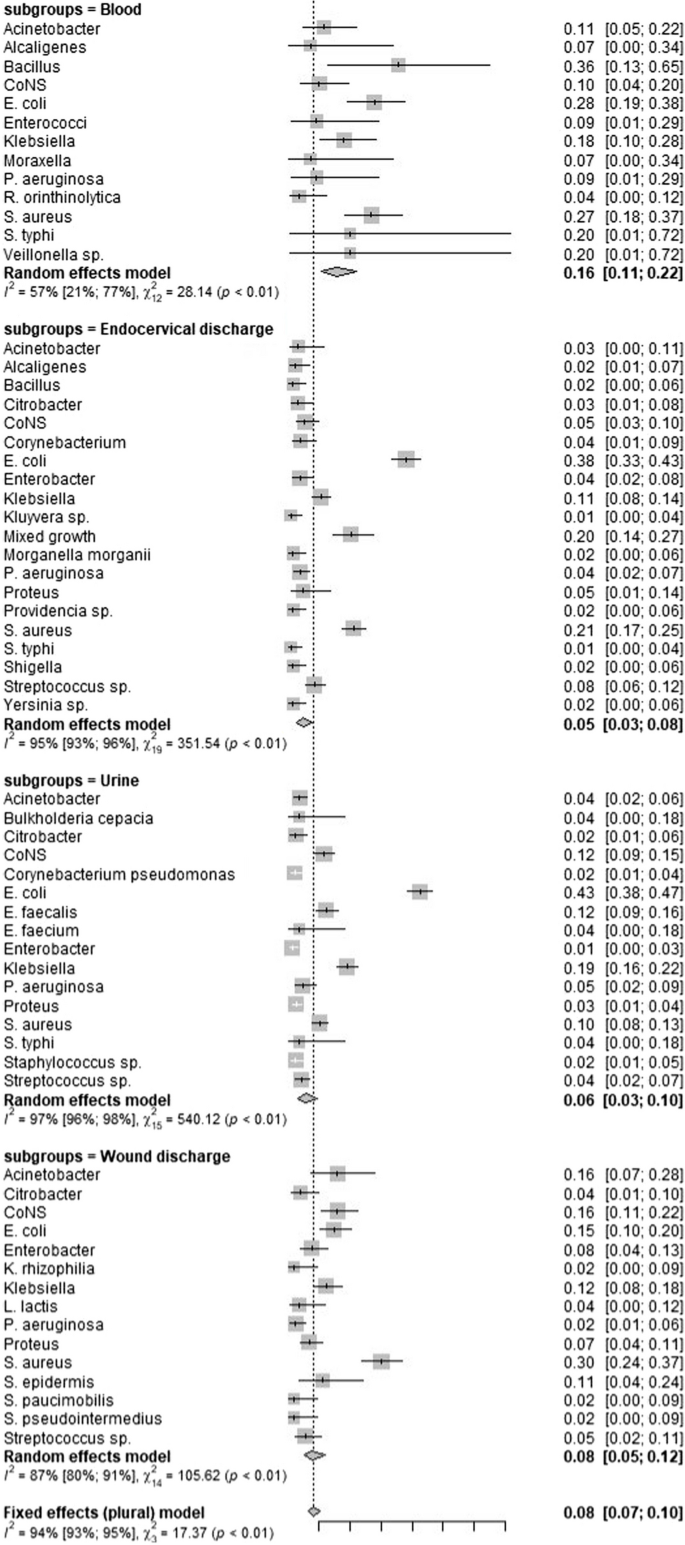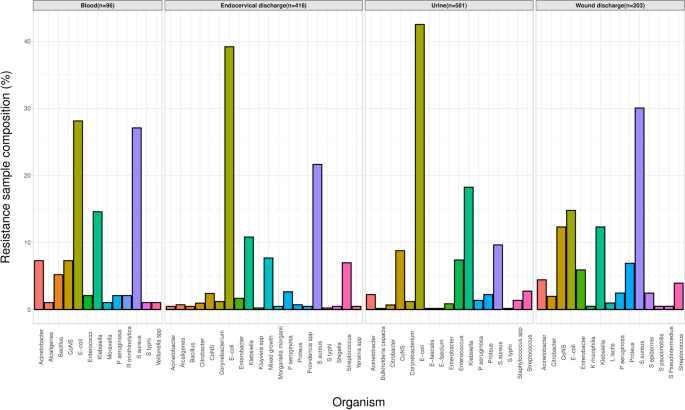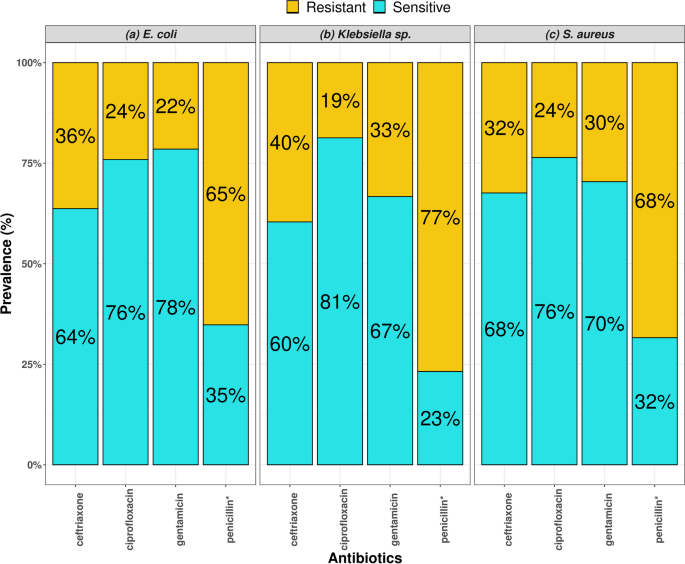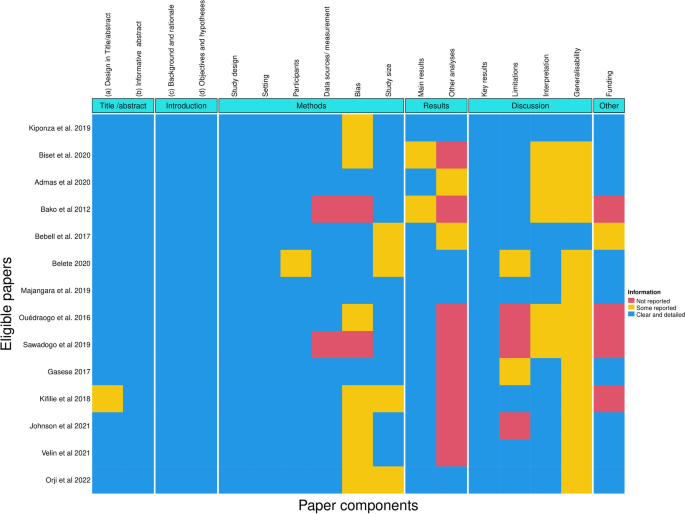- Systematic Review
- Open access
- Published:
The aetiology and antimicrobial resistance of bacterial maternal infections in Sub-Saharan Africa—a systematic review and meta-analysis
BMC Infectious Diseases volume 24, Article number: 978 (2024)
Abstract
Background
Understanding the aetiological organisms causing maternal infections is crucial to inform antibiotic treatment guidelines, but such data are scarce from Sub-Saharan Africa (SSA). We performed this systematic review and meta-analysis to address this gap.
Methods
Microbiologically confirmed maternal infection data were collected from PubMed, Embase, and African Journals online databases. The search strategy combined terms related to bacterial infection, pregnancy, postnatal period, observational studies, SSA. Exclusion criteria included colonization, asymptomatic infection, and screening studies. Pooled proportions for bacterial isolates and antimicrobial resistance (AMR) were calculated. Quality and completeness of reporting were assessed using the Newcastle–Ottawa and STROBE checklists.
Findings
We included 14 papers comprising data from 2,575 women from four sources (blood, urine, surgical wound and endocervical). Mixed-growth was commonly reported at 17% (95% CI: 12%-23%), E. coli from 11%(CI:10%-12%), S. aureus from 5%(CI: 5%-6%), Klebsiella spp. at 5%(CI: 4%- 5%) and Streptococcus spp. at 2%(CI: 1%-2%). We observed intra-sample and inter-sample heterogeneity between 88–92% in all meta-analyses. AMR rates were between 19% -77%, the highest with first-line beta-lactam antibiotics. Convenience sampling, and limited reporting of laboratory techniques were areas of concern.
Interpretation
We provide a comprehensive summary of microbial aetiology of maternal infections in SSA and demonstrate the paucity of data available for this region. We flag the need to review the current local and international empirical treatment guidelines for maternal bacterial infections in SSA because there is high prevalence of AMR among common causative bacteria.
Funding
This research was supported by the NIHR-Professorship/NIHR300808 and the Wellcome-Strategic-award /206545/Z/17/Z.
Trial registration
Prospero ID CRD42021238515.
Evidence before this study
-
Global frequency for infection-related severe maternal outcomes is 70.4 per 1000 livebirths in Low and Middle-Income Countries (LMIC) and 10.9 per 1000 livebirths in High-Income countries (HIC).
-
The World Health Organisation (WHO) international empiric clinical treatment guidelines for maternal infection in LMICs recommend ampicillin (a penicillin) and once-daily gentamicin as first-line antibiotics for treating maternal peripartum infections, and a combination of clindamycin and gentamicin for postpartum endometritis. The WHO also recommends amoxicillin for lower urinary tract infections and a medical review for other causes, such as soft tissue infections.
-
There is still no global data on the microbial aetiology of maternal infections, which is needed to guide management of maternal infections in LMIC, where the burden of disease is the highest
Added value of the study
This study summarizes the available microbial aetiology and the antibiotic susceptibility profiles for the causative bacterial agents for maternal infection in Sub-Saharan Africa (SSA). It also estimates the prevalence, diagnostic yield and antimicrobial drug resistance patterns of symptomatic and clinically relevant maternal bacteraemia, bacteriuria, endometritis, and soft tissue infection. This study also demonstrates the limited and scanty evidence available for the microbiology of maternal infection.
Implications of all the available evidence
-
There is a need for high-quality surveillance of maternal microbiological data in this context.
-
This study provides the best evidence to inform empirical treatment guidelines for local and international maternal infections.
-
This study also flags the need to review the current local and international treatment guidelines for maternal bacterial infections in SSA because the results of this study indicate a high prevalence of AMR in common causative events of maternal infections to commonly used antimicrobial drugs in SSA.
Introduction
Over the past 25 years, there has been a 44% decrease in Maternal Mortality Ratio (MMR) globally [1], which falls well short of the 2015 Millennium Development Goal target of a 75% reduction in MMR [2]. There is therefore an urgent need to strengthen efforts to reduce maternal mortality if the Sustainable Development Goals target, to reduce MMR to less than 70 per 100,000 live births by 2030 is to be met [3].
The global burden of maternal deaths is highest in Sub-Saharan Africa (SSA) [4, 5]. Over two-thirds of global maternal deaths occur in SSA, with at least 200,000 deaths per year [6, 1]. Of these deaths, up to 10% are due to infection which is twice the proportion observed in high income countries [7]. The problem's origins lie in the low quality of care areas, including inconsistent infection prevention, poor infection treatment, delayed sepsis diagnosis, and inadequate sepsis management. In addition, limited availability of validated diagnostics (culture and sensitivity) poses difficulties in prompt identification and management of maternal infection in SSA [8]. Therefore, prioritizing surveillance in this arena to describe the existing landscape of maternal infections in this region is essential to guide simple strategies to prevent morbidity and mortality from maternal infections. It also has the potential to reduce maternal death rates globally.
Data on the microbiologic causes of bacterial maternal infections can inform policies (programme strategies and treatment guidelines) and identify antimicrobial resistance (AMR) threats in SSA. However, there are challenges in estimating maternal sepsis burden due to differences in its definitions [9, 10]. Notably, within obstetrics there are a broad range of clinically relevant infections and infection sources that are associated with maternal sepsis. These include infections from the urogenital tract, but also infections associated with other organ systems, such as pneumonia. The World Health Organization (WHO) has therefore proposed a broad definition for maternal sepsis which we used for this systematic review to describe any “symptomatic maternal bacterial infection”. It spans across the pregnancy period spectrum, including the antenatal, peripartum, postpartum, and post-abortion periods (up to 42 days of pregnancy termination). It also incorporates an extensive host of infectious morbidities, including genital tract infections (e.g., chorioamnionitis and endometritis), extra-genital infections (e.g., surgical site infections), as well as other maternal bacterial infections complicating pregnancy, childbirth, and the puerperium (e.g., sexually transmitted infections (STIs), urinary tract infections (UTIs) [10].
Despite significantly higher maternal infection-related mortality in SSA, to date there has been no systematic review that summarizes the underlying microbiological agents causing maternal bacterial infection in SSA, nor their resistance patterns. Therefore, using the WHO definition of maternal infection and sepsis, this systematic review will summarise the available data on the main bacterial agents causing maternal infection and their susceptibility to antibiotics to inform the international and local current empiric antibiotic treatment guidelines. It will also assess completeness and quality of the available data.
Methods
Registration
This systematic review is registered with the International Prospective Register of Systematic Reviews (PROSPERO) on March 2021 (Registration number: CRD42021238515).
Search strategy and selection criteria
We searched PUBMED, Embase and African Journals online databases using a search strategy that combined terms relating to laboratory-confirmed bacterial infection, pregnancy, postnatal period, observational studies, and SSA (Supplementary I). A comprehensive literature search (last search 29th March 2023) was performed through the three databases with the support of a clinical librarian. The search did not contain letters or editorials. We used the “humans”, “female”, and “age” filters. We translated non-English articles. We also searched the systematic review registries for ongoing reviews.
We included any observational study (cohort, case–control, and cross-sectional studies) describing the aetiology and antimicrobial resistance (AMR) patterns of maternal bacterial infection in SSA. This review considered any studies that evaluated symptomatic laboratory-confirmed bacterial infection in keeping with the WHO definition of maternal infection/sepsis among pregnant and postpartum women (up to 42 days after birth). We excluded papers that contained incomplete/internally inconsistent data, that assessed the diagnostic accuracy of any test using only positive samples and that were not in the clinical context of suspected maternal infection. We excluded studies that only described maternal colonization of bacteria rather than infection; for example, maternal colonization of Group B streptococci (GBS) in neonatal infection. Screening studies that did not include women who fulfil the WHO definition were also excluded, for example, studies that evaluated the prevalence of sexually transmitted infections among women attending routine clinical check-ups. Finally, we excluded studies reporting on only one type of bacteria as this may skew proportional estimates.
Two independent authors (CC and CVD) screened titles and abstracts with aid from a librarian (AS) in Rayyan. Duplicates were removed and reviewed individually by CC and CVD. If at least one of the authors approved the study, we obtained the full-text report. In both stages, we compared the results against eligibility criteria. CC and CVD resolved disagreements through discussion; if they could not reach an agreement, a third author (DL) resolved the disagreement.
Data collection and extraction
Using a Microsoft Excel database, CC and CVD extracted the following data from the eligible full-text studies; identification details of the study, including the title, language, authors, year of publication, country, region, setting (urban or rural), study design, study inclusion and exclusion criteria; participant characteristics, including participants’ age (median and range), gestation period, co-morbidities (for example, HIV status) and study sample size; exposure of interest, such as type of bacterial infection (invasive or non-invasive), source of infection, when the invasive bacterial infection occurred (antenatal/postnatal); and outcomes of interest, namely the number and type of samples taken, number of positive samples; the diagnostic method used, antimicrobial susceptibility testing results and the methodology used, and maternal outcomes (if reported).
We contacted the study correspondence authors for further information for studies published only as abstracts. For study reports containing little details on methods and results, we also contacted the authors to obtain additional information on these elements. Disagreements regarding the data extracted were resolved by discussion and, if necessary, by consulting a third review author (DL).
Data analysis
The analysis was conducted in R (R Core Team, 2022), using RStudio [11]. We applied the metafor package [12] to perform a meta-analysis of; i prevalence (number of causative agent of interest/total number of samples assessed) and, ii diagnostic yield (number of causative agent of interest/total number of positive isolates; and their 95% confidence intervals) [12]. Pooled estimates from the eligible studies on each causative agents of maternal bacterial infections were estimated using random-effects models (REM) and the DerSimonian-Laird method [13]. We also performed sub-group meta-analyses according to the source of infection; and estimated pooled proportions of antimicrobial resistance for the commonest bacteria for the papers that reported on antibiotic susceptibility.
Completeness and quality assessments of the papers
To assess reporting completeness and quality of included studies, two authors (CVD with either EJMM or EB) independently assessed included studies according to Strengthening the Reporting of Observational Studies in Epidemiology [14,15,16] and the Newcastle–Ottawa Scale [17, 18], respectively. They then independently applied the checklists to each included study. Both checklists were adopted to better serve reporting of microbiological data.
Results
This systematic review and meta-analysis database search identified 3108 papers for abstract screening after removing duplicates (Fig. 1). Fifty-eight papers were eligible for full-text review; 12 articles were excluded because of no correspondence from authors in studies that reported little detail on results; three papers were on premature rupture of membranes (PROM) screening, six papers had no microbiological data, two were microbiome papers, 20 articles targeted the wrong population, and one article had incoherent results. Therefore, 14 articles were eligible for data extraction. All 14 articles reported data on aetiology, and ten reported on AMR. Two articles were in French [19, 20] and translated by EM and CVD prior to analysis.
The main characteristics of the papers included in this systematic review and meta-analysis are summarised in Table 1 and the geographical distribution in Fig. 2. Eight studies were from East Africa (five from Ethiopia), two from Southern Africa and three from West Africa (Fig. 2). The proportion of study participants with suspected maternal infection who had laboratory confirmed diagnosis ranged from 20.4% to 100%.
Figure 3 shows a forest plot of the pooled proportion of the reported causative agents of bacterial maternal infection for all sample types combined. Overall, mixed growth was reported most at 17% (CI: 12%—23%), followed by E. coli at 11% (CI:10%—12%), S. aureus at 5% (CI: 5% -6%), S. epidermis at 7% (CI: 2%, 16%), Klebsiella spp. at 5% (CI: 4%-5%), L. lactis at 5% (CI:1%-15%) and Coagulase negative Staphylococci (CONS) was 3% (CI:2%-4%).
When we stratified the data by sample type (Fig. 4); blood culture was rarely positive at 2% (CI: 2%-3%), of which growth for Klebsiella spp. at 4% (CI: 2%-6%), S. aureus at 4% (CI: 2%-5%) and E. coli at 4% (CI: 3%-6%) was most reported. Around 4% (CI: 2% -6%) of endocervical discharge samples yielded positive cultures of which the majority yielded E. coli at 25% (CI:22%-29%), mixed growth at 17% (CI: 12%-23%) and S. aureus at 14% (CI: 11%-17%). The urine cultures were positive in 1% of cases (CI: 1%-2%). The most common pathogens identified were Klebsiella spp at 4% (CI: 3%-5%), S. aureus at 2% (CI: 2%-3%), and E. coli at 9% (CI: 8%-10%). Approximately 8% (CI: 5–12%) of wound samples generated positive cultures of which the majority showed growth for S. aureus at 30% (CI: 24%-37%) followed by Acinetobacter (16%; CI: 7%-28%). Notably, we observed both intra-sample and inter-sample heterogeneity in both meta-analyses ranging from 79–96%.
For samples yielding positive cultures, we pooled the proportion of each causative agent (Fig. 5). Overall, the predominant causative agents among positive cultures were E. coli at 36% (CI: 33%-38%), mixed growth at 20% (CI: 14%-27%), Veillonella spp. at 20% (CI: 1%-72%), S. aureus at 18% (CI: 16%-20%), and Klebsiella spp. at 15% (CI: 13%-17%). The forest plot in Fig. 6 shows the pooled proportion stratified by sample type. Positive samples from cervicovaginal and urine most commonly yielded E coli, at 38% (CI: 33%-43%) and 43% (CI:38%-47%), respectively; while wound swabs yielded S aureus at 28% (CI: 22%-34%). We also observed both intra-sample and inter-sample heterogeneity in both meta-analyses ranging from 80–96%. Similarly, Fig. 7 presents a stratified bar graph based on sample sources, namely blood, endocervical discharge, urine, and wound discharge. The graph illustrates the composition of resistant samples for each bacterium. The data reveals that among all resistant bacteria, E. coli is the most frequently isolated bacterium from blood (n = 27/ 96, 28%), urine (n = 247/ 581, 43%), and endocervical samples (n = 163/ 416, 39%). In contrast, S. aureus (61/ 203, 30%) is predominantly isolated from surgical wound sites.
We summarized pooled antibiotic susceptibility testing (AST) profiles E. coli, Klebsiella spp. and S aureus (reported from the studies) to commonly used WHO classes of antibiotics in SSA; penicillin (amoxicillin and ampicillin), gentamicin, ciprofloxacin, and ceftriaxone (Fig. 8) as these were the most common clinically relevant antibiotics retrieved from this meta-analysis. Notably, there was limited data on third-line treatments carbapenems, and co-trimoxazole. The pooled resistance of E. coli to Penicillin (amoxicillin and ampicillin), gentamicin, ciprofloxacin, and ceftriaxone was 65%, 22%, 24% and 36%, respectively. The pooled resistance of Klebsiella spp. to penicillin (amoxicillin and ampicillin), gentamicin, ciprofloxacin, and ceftriaxone was 77%, 33%, 19% and 40%, respectively. The pooled resistance of S. aureus to penicillin (amoxicillin and ampicillin), gentamicin, ciprofloxacin, and ceftriaxone was 68%, 30%, 24%, and 32%, respectively.
The assessment of strength of reporting within each included study, according to the STROBE criteria, is summarized in Fig. 9. We assessed completeness of reporting using the STROBE checklist, including the title, introduction, methodology, results, discussion, and funding. Of the criteria assessed, bias reporting was the least well-reported methods criteria (only 5/14 [35.7%] addressed bias clearly). Other criteria that should have been reported more comprehensively were the limitations of the studies and funding sources. The main study results of interest for this review, however, were clear and detailed for all included studies.
Supplementary II summarises the quality of the 14 papers included in the study using the Newcastle–Ottawa score. We determined the risk of bias in each article by assessing its ability to represent the exposed group, ascertain the exposed group, control for confounding, and make an outcome assessment. Notably, all studies dropped at least three points, spread across 2–3 assessment categories, with 8/14 (57.1%) dropping two points in a single category and at particular risk of introducing bias. The main reasons for introducing bias were use of convenience sampling rather than random sampling of included patients, lack of laboratory facilities to perform anaerobic culture, minimal to no control of confounding (for e.g., antibiotic exposure, HIV status), no or insufficient differentiation in outcome assessment regarding commensal contamination versus pathogen.
Discussion
Here we performed a systematic review of the literature summarizing available aetiological and antimicrobial resistance data on bacterial maternal infections in SSA. Our study shows that E. coli, S. aureus, and Klebsiella spp. are the most common pathogens associated with maternal infections. Notably, E. coli and Klebsiella spp. are commonly and intrinsically resistant to penicillin, respectively. At least 21.5% of these isolates (E. coli, S. aureus, and Klebsiella spp.) exhibited resistance to other first-line and second-line antibiotics, including ciprofloxacin and gentamicin. Additionally, up to 39.6% of these isolates were resistant to ceftriaxone, a second-line treatment.
Our findings are consistent with the 2022 Global Antimicrobial Resistance and use Surveillance System (GLASS) [33]. In their report, the WHO reported third-generation cephalosporin- resistance for E. coli at 42%, K. pneumoniae between (59% – 65%) and methicillin-resistant S. aureus (MRSA) at 35% causing bloodstream infections [33]. In addition, resistance rates of E. coli to first-line antibiotics (penicillins) and second-line drugs (ciprofloxacin) were both > 20% and of great concern. A notable limitation of GLASS data is the lack of stratified data on age and gender, and it did not specifically look at the pregnant/post-partum population to inform the global picture of bacterial infection and AMR. This challenge limits the data interpretation in the context of maternal infections. For this population analysing AMR surveillance data by age groups and infection types are crucial to informing and directing mitigation strategies and interventions to control the mechanisms of the spread of the causative agents and AMR. In addition, some antibiotics used in the general population cannot be used in pregnancy due to adverse effects on the unborn infant. Therefore, these factors need to be accounted for in the surveillance systems.
Our systematic review and meta-analysis provide stratified maternal infection data, but it has some limitations. For example, the reporting AST of K. pneumoniae to co-trimoxazole and carbapenems is of public health relevance because resistance genes in Enterobacterales to these antibiotics are frequently associated with mobile genetic elements that increase the likelihood of pan-drug-resistant and extreme-drug-resistant isolates. Our study could not assess the resistance of carbapenems and co-trimoxazole due to limited data to make such pooled estimates. This likely reflects the local prescribing behaviour as third-generation drugs such as carbapenems are rarely available. Nonetheless, rising ESBL rates may incentivize the use of carbapenems and co-trimoxazole, making urgent surveillance of resistance to these antibiotics essential. Another challenge was that the studies included in our meta-analyses were performed in government and mostly tertiary hospitals and not private or primary healthcare facilities. Therefore, the data presented here may be skewed in the direction of hospital-acquired (resistant) bacterial infection as prior antibiotic exposure was not always reported and/or accounted for. Nonetheless, most patients in SSA with severe maternal infection will attend government hospitals.
Quality assessment of the papers shows some areas of concern. Most studies report convenience sampling of patients with suspected maternal sepsis and no randomized sampling was reported, which may limit the generalizability of the findings to the wider maternal population. This in addition to the lack of information on prior antibiotic exposure means there may be common infectious agents responsive to empiric treatments which were not captured within this review. Limited studies reported anaerobic culturing methods meaning important pathogens could have been missed. Only 3/7 studies reported in their methodology that they accounted for contaminants making data from non-sterile sampling sites such as wounds and cervicovaginal swabs difficult to interpret [19,20,21, 24, 27, 29, 31]. Also, some studies reported resistance to penicillin by Gram-negative causative agents (known to be inherently resistant to penicillin). We would have liked to stratify our analyses by important factors such as HIV status, considering that HIV increases the risk of maternal morbidity and mortality, but HIV-status data was missing for most studies. Majangara et al. [27] was the only study reviewed here that stratified data according to HIV status and reported increased length of hospitalization stay for HIV positive women with puerperal sepsis but they did not find a specific microbial agent that significantly associated with HIV status.
We expected to see high clinical and statistical heterogeneity, as demonstrated by the results (inter- and intra-study heterogeneity 88–92% in all the meta-analyses performed). This heterogeneity can be explained by our summary table and subgroup analysis by sample type. However, pooled estimates from these papers are still clinically relevant.
In light of these findings, several crucial implications emerge. Firstly, the apparent deficiency in data underscores the pressing need for concerted efforts in systematic data collection, particularly from government laboratories. Such initiatives are essential not only for assessing sensitivities but also for obtaining accurate and comprehensive rates of AMR. The limited availability of robust data poses a significant challenge to achieving the WHO's universal health care ambition. Additionally, the identified low rates of bacterial detection in laboratory settings raise questions about the utility of current practices. It prompts reflection on whether these detection rates are reasonable, considering their potential impact on the quality of treatment. The ability to deliver high-quality treatment is directly influenced by the accuracy and reliability of laboratory results, emphasizing the importance of addressing and rectifying potential limitations in detection methods.
Furthermore, the documented high rates of treatment failure (for invasive and non-invasive bacterial infections), particularly alarming in resource-constrained populations, emphasize the critical need for immediate attention. In economically challenged settings where financial constraints limit the purchase of various antibiotics, and follow-up is challenging in the face of detected resistance, effective treatment becomes a formidable challenge. This warrants a comprehensive re-evaluation of current guidelines and practices, especially in the context of syndromic treatment. The data strongly suggests the necessity for revisions to existing guidance to ensure that the first-line treatment is appropriately targeted and effective.
Conclusion
Our findings highlight the need for high-quality surveillance for maternal microbiological data in SSA, including stratification according to the target demographic population. The results indicate a high prevalence of resistance in common causative agents of maternal infections to essential antimicrobial drugs in empirical treatment guidelines. These include ampicillin (a penicillin) as first-line antibiotics for treating maternal peripartum infection in combination with gentamicin. AMR has also been observed in amoxicillin and ceftriaxone, the highest priority agent among the critically important antimicrobials for human medicine. Our findings also flag the need to review local and international treatment guidelines for maternal bacterial infections in SSA.
Availability of data and materials
Data are available upon reasonable request to the corresponding author.
References
WHO, UNICEF, UNFPA WBG and the UNPD. WHO | Trends in maternal mortality: 1990 to 2015. WHO. 2016. p. 18–25. Available from: https://www.who.int/reproductivehealth/publications/monitoring/maternal-mortality-2015/en/. Cited 2021 Aug 26.
Chatterjee DK. United Nations Millennium Development Goals. In: Encyclopedia of Global Justice. 2011. p. 1105–1105. Available from: https://www.un.org/millenniumgoals/maternal.shtml. Cited 2021 Aug 26.
UNSD, DESA. SDG Indicators — SDG Indicators. United Nations Statistics Division, Department of Economic and Social Affairs. 2017. Available from: https://unstats.un.org/sdgs/metadata/?Text=&Goal=3&Target=3.1. Cited 2021 Aug 26.
Bonet M, Brizuela V, Abalos E, Cuesta C, Baguiya A, Chamillard M, et al. Frequency and management of maternal infection in health facilities in 52 countries (GLOSS): a 1-week inception cohort study. Lancet Glob Health. 2020;8(5):661–71 Available from: www.thelancet.com/lancetgh. Cited 2021 Jan 4.
Chou D, Daelmans B, Jolivet RR, Kinney M, Say L. Ending preventable maternal and newborn mortality and stillbirths. BMJ (Online). 2015;351:19–22 Available from: www.who.int/reproductivehealth. Cited 2021 Aug 26.
UNICEF. Maternal mortality rates and statistics - UNICEF DATA. UNICEF Data: Monitoring the situation of children and women. 2019. p. 1–8. Available from: https://data.unicef.org/topic/maternal-health/maternal-mortality/. Cited 2022 Feb 20.
Say L, Chou D, Gemmill A, Tunçalp Ö, Moller AB, Daniels J, et al. Global causes of maternal death: A WHO systematic analysis. Lancet Glob Health. 2014;2(6):e323–33. Available from: http://www.thelancet.com/article/S2214109X1470227X/fulltext. Cited 2024 Sep 9.
Iskandar K, Molinier L, Hallit S, Sartelli M, Hardcastle TC, Haque M, et al. Surveillance of antimicrobial resistance in low- and middle-income countries: a scattered picture. Antimicrob Resist Infect Cont. 2021;10(1):1–19. https://doi.org/10.1186/s13756-021-00931-w. Available from: https://aricjournal.biomedcentral.com/articles/. Cited 2023 Feb 13.
Singer M, Deutschman CS, Seymour C, Shankar-Hari M, Annane D, Bauer M, et al. The third international consensus definitions for sepsis and septic shock (sepsis-3). JAMA. 2016;315:801–10 Available from: https://jamanetwork.com/journals/jama/fullarticle/2492881. Cited 2021 Aug 26.
Bonet M, Nogueira Pileggi V, Rijken MJ, Coomarasamy A, Lissauer D, Souza JP, et al. Towards a consensus definition of maternal sepsis: results of a systematic review and expert consultation Reproductive Health. BioMed Cent. 2017;14:1–13. https://doi.org/10.1186/s12978-017-0321-6. Available from: https://reproductive-health-journal.biomedcentral.com/articles. Cited 2021 Aug 26.
R Core Team. R Foundation for Statistical Computing, Vienna. R: A Language and Environment for Statistical Computing. Available from: www.R-project.org. 2021. Cited 2023 Feb 21.
Viechtbauer W. Conducting Meta-Analyses in R with the metafor Package. J Stat Softw. 2010;36(3):1–48 Available from: https://www.jstatsoft.org/index.php/jss/article/view/v036i03. Cited 2023 Apr 27.
DerSimonian R, Laird N. Meta-analysis in clinical trials. Control Clin Trials. 1986;7(3):177–88 Available from: https://pubmed.ncbi.nlm.nih.gov/3802833/. Cited 2023 Apr 27.
Vandenbroucke JP, Von Elm E, Altman DG, Gøtzsche PC, Mulrow CD, Pocock SJ, et al. Strengthening the Reporting of Observational Studies in Epidemiology (STROBE): Explanation and elaboration. PLoS Med. 2007;4(10):1628–54.
von Elm E, Altman DG, Egger M, Pocock SJ, Gøtzsche PC, Vandenbroucke JP. The strengthening the reporting of observational studies in epidemiology (STROBE) statement: Guidelines for reporting observational studies. Int J Surg. 2014;12(12):1495–9.
Cuschieri S. The STROBE guidelines. Saudi J Anaesth. 2019;13(Suppl 1):S31–4 Available from: http://www.ncbi.nlm.nih.gov/pubmed/30930717. Cited 2023 May 15.
Newcastle-Ottawa Scale: comparing reviewers’ to authors’ assessments - PMC. Available from: https://www.ncbi.nlm.nih.gov/pmc/articles/PMC4021422/. Cited 2023 May 15.
Lo CKL, Mertz D, Loeb M. Newcastle-Ottawa Scale: comparing reviewers’ to authors’ assessments. BMC Med Res Methodol. 2014;14(1):45 Available from: /pmc/articles/PMC4021422/ . Cited 2023 May 15.
Sawadogo YA, Komboigo E, Kiemtore S, Zamane H, Ouedraogo I, Kain DP, et al. Les suppurations pariétales postcesariennes au Centre Hospitalier Universitaire Yalgado Ouedraogo, Burkina-Faso: aspects epidemiologiques, cliniques, thérapeutiques et pronostiques. Pan Afr Med J. 2019;32:1937–8688. https://doi.org/10.11604/pamj.2019.32.35.17167. Cited 2024 Jan 8.
Ouédraogo CMR, Ouattara A, Sana A, Ouédraogo A, Kain DP, Komboigo E, et al. Les endométrites obstétricales au CHU-Yalgado Ouédraogo de Ouagadougou (Burkina Faso). À propos de la prise en charge d’une série de 102 cas. Bulletin de la Societe de Pathologie Exotique. 2016;109(5):334–9. https://doi.org/10.1007/s13149-016-0514-1. Available from: https://link.springer.com/article/. Cited 2023 May 1.
Kiponza R, Balandya B, Majigo MV, Matee M. Laboratory confirmed puerperal sepsis in a national referral hospital in Tanzania: Etiological agents and their susceptibility to commonly prescribed antibiotics. BMC Infect Dis. 2019;19(1):690. https://doi.org/10.1186/s12879-019-4324-5. Available from: https://bmcinfectdis.biomedcentral.com/articles/. Cited 2021 Apr 15.
Biset S, Moges F, Endalamaw D, Eshetie S. Multi-drug resistant and extended-spectrum β-lactamases producing bacterial uropathogens among pregnant women in Northwest Ethiopia. Ann Clin Microbiol Antimicrob. 2020;19(1):1–9. https://doi.org/10.1186/s12941-020-00365-z. Available from: https://ann-clinmicrob.biomedcentral.com/articles/. Cited 2023 May 1.
Admas A, Gelaw B, Belay T, Worku A, Melese A. Proportion of bacterial isolates, their antimicrobial susceptibility profile and factors associated with puerperal sepsis among post-partum/aborted women at a referral Hospital in Bahir Dar. Northwest Ethiopia Antimicrob Resist Infect Control. 2020;9(1):1–10. https://doi.org/10.1186/s13756-019-0676-2 Available from: https://aricjournal.biomedcentral.com/articles/ Cited 2023 May 1.
Bako B, Audu BM, Lawan ZM, Umar JB. Risk factors and microbial isolates of puerperal sepsis at the University of Maiduguri Teaching Hospital, Maiduguri. North-eastern Nigeria Arch Gynecol Obstet. 2012;285(4):913–7. https://doi.org/10.1007/s00404-011-2078-4. Available from: https://link.springer.com/article. Cited 2023 May 1.
Bebell LM, Ngonzi J, Bazira J, Fajardo Y, Boatin AA, Siedner MJ, et al. Antimicrobial-resistant infections among postpartum women at a Ugandan referral hospital. PLoS One. 2017;12(4):e0175456 Available from: https://journals.plos.org/plosone/article?id=. Cited 2023 May 1.
Belete MA.Bacterial Profile and ESBL Screening of Urinary Tract Infection Among Asymptomatic and Symptomatic Pregnant Women Attending Antenatal Care of Northeastern Ethiopia Region. Infect Drug Resist. 2020;13:2579–92 Available from: https://www.dovepress.com/bacterial-profile-and-esbl-screening-of-urinary-tract-infection-among--peer-reviewed-fulltext-article-IDR. Cited 2023 May 1.
Majangara R, Chirenje ZM, Gidiri MF. The association of puerperal sepsis with HIV infection at two tertiary hospitals in Zimbabwe HHS Public Access. Int J Gynaecol Obstet. 2019;144(1):67–72.
Gessese YA, Damessa DL, Amare MM, Bahta YH, Shifera AD, Tasew FS, et al. Urinary pathogenic bacterial profile, antibiogram of isolates and associated risk factors among pregnant women in Ambo town, Central Ethiopia: a crosssectional study. Antimicrob Resist Infect Control. 2017;6(1). Available from: https://pubmed.ncbi.nlm.nih.gov/29299306/. Cited 2024 Jan 8.
Kifilie AB, Dagnew M, Tegenie B, Yeshitela B, Howe R, Abate E. Bacterial Profile, Antibacterial Resistance Pattern, and Associated Factors from Women Attending Postnatal Health Service at University of Gondar Teaching Hospital, Northwest Ethiopia. Int J Microbiol. 2018;2018. Available from: https://pubmed.ncbi.nlm.nih.gov/29681942/. Cited 2024 Jan 8.
Johnson B, Stephen BM, Joseph N, Asiphas O, Musa K, Taseera K. Prevalence and bacteriology of culture-positive urinary tract infection among pregnant women with suspected urinary tract infection at Mbarara regional referral hospital. South-Western Uganda BMC Pregnancy Childbirth. 2021;21(1):1–9. https://doi.org/10.1186/s12884-021-03641-8. Available from: https://bmcpregnancychildbirth.biomedcentral.com/articles/. Cited 2023 May 1.
Velin L, Umutesi G, Riviello R, Muwanguzi M, Bebell LM, Yankurije M, et al. Surgical Site Infections and Antimicrobial Resistance After Cesarean Section Delivery in Rural Rwanda. Ann Glob Health. 2021;87(1):77–8. https://doi.org/10.5334/aogh.3413 Available from: https://annalsofglobalhealth.org/articles/. Cited 2023 May 1.
Kifilie AB, Dagnew M, Tegenie B, Yeshitela B, Howe R, Abate E. Bacterial Profile, Antibacterial Resistance Pattern, and Associated Factors from Women Attending Postnatal Health Service at University of Gondar Teaching Hospital, Northwest Ethiopia. Int J Microbiol. 2018;2018. Available from: https://pubmed.ncbi.nlm.nih.gov/29681942/. Cited 2024 Jan 8.
Global antimicrobial resistance and use surveillance system (GLASS) report: 2022. Available from: https://www.who.int/publications/i/item/9789240062702. Cited 2023 Feb 13.
Clinical trial number
Not applicable.
Funding
This work was funded by the NIHR Professorship, NIHR300808 (DL). CC was also supported by an institutional training grant awarded as part of the Wellcome Strategic award number 206545/Z/17/Z to The Malawi-Liverpool- Research Programme (MLW), administered under the joint MLW/Kamuzu University of Health Sciences Training Committee. For the purpose of open access, the authors have applied a CC BY public copyright license to any author accepted manuscript version arising from this submission. The views expressed in this publication are those of the authors and not those of the funders.
Author information
Authors and Affiliations
Contributions
DL is the guarantor of this manuscript. DL, CC and CVD developed the research question. CC, CVD and AS devised the search strategy. CC, CVD, EJMM and EB performed data extraction and quality assessments of the papers. CC, HHT and JF performed the data analysis. AW, NF, SL, DK, LG, MN, CM, TN, CD and MKM made substantial contributions to the study design. CC and CVD drafted the manuscript. All authors have read and approved the final manuscript.
Corresponding author
Ethics declarations
Ethical approval and consent to participate
Not applicable.
Competing interests
The authors declare no competing interests.
Additional information
Publisher’s Note
Springer Nature remains neutral with regard to jurisdictional claims in published maps and institutional affiliations.
Rights and permissions
Open Access This article is licensed under a Creative Commons Attribution-NonCommercial-NoDerivatives 4.0 International License, which permits any non-commercial use, sharing, distribution and reproduction in any medium or format, as long as you give appropriate credit to the original author(s) and the source, provide a link to the Creative Commons licence, and indicate if you modified the licensed material. You do not have permission under this licence to share adapted material derived from this article or parts of it. The images or other third party material in this article are included in the article’s Creative Commons licence, unless indicated otherwise in a credit line to the material. If material is not included in the article’s Creative Commons licence and your intended use is not permitted by statutory regulation or exceeds the permitted use, you will need to obtain permission directly from the copyright holder. To view a copy of this licence, visit http://creativecommons.org/licenses/by-nc-nd/4.0/.
About this article
Cite this article
Chapuma, C., Twabi, H.H., Monk, E.J.M. et al. The aetiology and antimicrobial resistance of bacterial maternal infections in Sub-Saharan Africa—a systematic review and meta-analysis. BMC Infect Dis 24, 978 (2024). https://doi.org/10.1186/s12879-024-09855-3
Received:
Accepted:
Published:
DOI: https://doi.org/10.1186/s12879-024-09855-3
